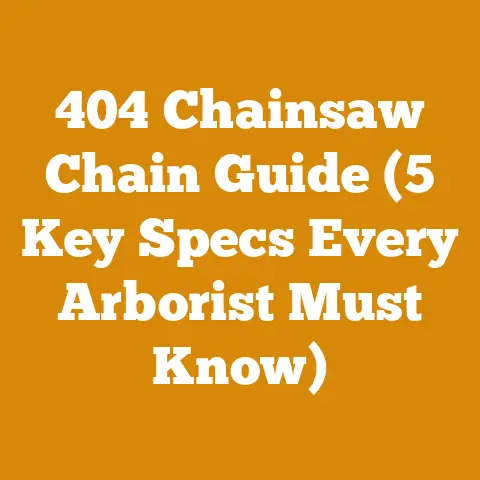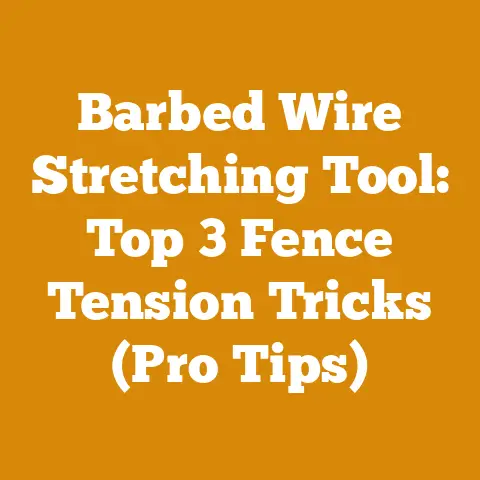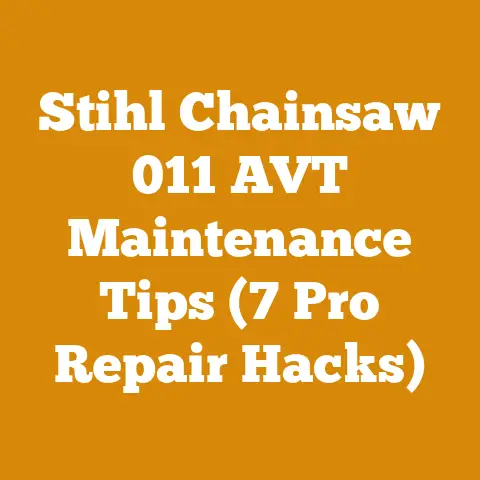Drive Links on Chainsaw: Using Extra Link Safely Explained (Pro Tips)
I remember the biting chill of that first winter after moving to our little cabin in the woods. The romantic dream of crackling fires and cozy evenings quickly met the stark reality of needing to actually get firewood. Fast. My initial fumbling attempts at chainsawing and splitting were, to put it mildly, inefficient. I spent more time wrestling logs and cursing dull chains than enjoying the warmth of the fire. It was a hard-won lesson: successful firewood preparation and wood processing aren’t just about brute strength; they’re about strategy, knowledge, and using the right tools correctly. This article is born from that experience – and years of refining my methods since. I’m going to share everything I’ve learned about optimizing your chainsaw, specifically focusing on the often-misunderstood topic of drive links, to help you work smarter, not harder, and stay safe in the process.
I’ve seen folks on forums swear blind that adding an extra link is a magic bullet for better cutting, while others warn of catastrophic consequences. The truth, as always, lies somewhere in between. My aim is to provide a clear, concise, and safe guide to understanding drive links, their purpose, and whether adding (or subtracting) one is right for your specific situation.
What Are Drive Links and Why Do They Matter?
Drive links are the small, tooth-like projections on the underside of your chainsaw chain. They engage with the sprocket on your chainsaw’s drive shaft and pull the chain around the bar. Think of them as the engine’s connection to the cutting teeth. The number of drive links on a chain is a critical factor in determining if that chain will fit your chainsaw.
- Fit is paramount: A chain with too few drive links will be too short to properly engage the sprocket and bar. A chain with too many drive links will be too loose, potentially derailing and causing serious injury.
- Gauge and Pitch: Drive links also determine the chain’s gauge (the thickness of the drive link that fits into the bar groove) and are related to the chain’s pitch (the distance between the rivets). These must match your chainsaw and bar specifications.
- Chain Speed and Cutting Efficiency: The drive links are responsible for transferring the power from the engine to the cutting teeth. If they are worn, damaged, or the wrong size, the chain will not cut efficiently.
Understanding the Numbers Game: Chain Specifications
Before we delve into adding or removing links, let’s decode the language of chainsaw chains. Every chain is defined by three key measurements:
- Pitch: Measured in inches (e.g., .325″, 3/8″), pitch refers to the distance between any three consecutive rivets on the chain divided by two. It’s essentially the spacing between the cutting teeth.
- Gauge: Measured in inches (e.g., .050″, .058″, .063″), gauge is the thickness of the drive links. It must match the width of the groove in your chainsaw bar.
- Drive Link Count: This is simply the number of drive links on the chain. This is the key number we are discussing.
These specifications are usually stamped on the chainsaw bar near the mounting point. If you can’t find them there, consult your chainsaw’s owner’s manual. Never guess these measurements. Using the wrong chain can damage your chainsaw and create a dangerous situation.
When (and Why) Might You Consider Adding a Drive Link?
Now, let’s address the burning question: when would you ever consider adding a drive link to a chainsaw chain? The answer is almost always: only in very specific and unusual circumstances.
- Bar Length Discrepancies (Rare): Sometimes, due to manufacturing tolerances or aftermarket bar purchases, a chain advertised for a specific bar length might be slightly too short. I emphasize slightly. We’re talking about needing one extra drive link, maybe two, not a wholesale re-engineering of the chain.
- Chain Stretch (Temporary Fix): Chains stretch over time as they wear. This is normal. However, excessive stretch can lead to the chain becoming too loose and potentially derailing. Adding a link can provide a temporary fix, but it’s usually a sign that the chain is nearing the end of its life and should be replaced.
- Experimental Setups (For Experts Only): Very experienced users might experiment with adding a link to fine-tune the chain tension and cutting performance. This is not recommended for beginners and should only be attempted with a thorough understanding of chainsaw mechanics.
Important Caveats:
- Adding multiple links is almost never a good idea. It indicates a significant problem with the chain or bar, and you should address the underlying issue instead.
- Adding a link will change the chain’s tension. This can affect cutting performance and safety. You’ll need to carefully adjust the chain tensioner to compensate.
- Never add a link to compensate for a worn-out bar. A worn bar will have a widened groove, causing the chain to be loose even with the correct number of links. Replace the bar instead.
How to Add a Drive Link Safely (Step-by-Step)
If you’ve determined that adding a drive link is the right course of action, follow these steps carefully:
- Gather Your Tools: You’ll need a chain breaker/rivet spinner tool (essential), a hammer, a punch, a file, and a new drive link that exactly matches the pitch and gauge of your existing chain. I recommend buying a small roll of chain that matches your existing chain so you have extra drive links, tie straps, and cutting links.
- Break the Chain: Using the chain breaker, carefully push out one of the rivets connecting two links on the chain. Follow the manufacturer’s instructions for your specific chain breaker tool.
- Insert the New Drive Link: Position the new drive link between the two open ends of the chain.
- Connect with a New Tie Strap: You’ll need a new tie strap (the link that connects the drive link to the cutting links). Place the tie strap over the drive link and the adjacent links.
- Rivet the Tie Strap: Using the rivet spinner tool, carefully peen over the ends of the rivet to secure the tie strap. Again, follow the manufacturer’s instructions for your tool. This is the most critical step. A poorly riveted link is a weak point in the chain and can fail under stress.
- File Down Any Sharp Edges: Use a file to smooth down any sharp edges on the new rivet.
- Check the Tension: Mount the chain on your chainsaw and adjust the chain tensioner. The chain should fit snugly around the bar, with the drive links properly engaged in the sprocket. You should be able to pull the chain away from the bar slightly, but it shouldn’t be excessively loose.
Safety First: Always wear safety glasses and gloves when working with chainsaw chains. Be extremely careful when using the chain breaker and rivet spinner tools, as they can be dangerous if used improperly.
Removing Drive Links: A More Common Scenario
While adding drive links is rare, removing them is a more common occurrence. This is usually done when:
- The Chain is Too Long (Common): You bought the wrong chain, or the chain was incorrectly manufactured.
- Repairing a Damaged Chain: If a section of the chain is damaged beyond repair, you might need to remove a few links to splice the chain back together.
- Shortening a Chain for a Shorter Bar: If you switch to a shorter bar on your chainsaw, you’ll need to remove links to match the new bar length.
The process of removing drive links is essentially the reverse of adding them. Use the chain breaker to push out the rivets connecting the links you want to remove, and then re-rivet the chain back together.
Chain Tension: The Key to Safety and Performance
Regardless of whether you’ve added or removed drive links, proper chain tension is absolutely crucial.
- Too Loose: A loose chain can derail, causing serious injury. It can also lead to uneven wear on the bar and sprocket.
- Too Tight: A tight chain can overheat, stretch, and even break. It also puts unnecessary strain on the chainsaw’s engine and bar.
Checking Chain Tension:
- Turn off the chainsaw and engage the chain brake.
- Wear gloves.
- Pull the chain away from the bar at the midpoint of the bar’s underside. You should be able to pull the chain away slightly, but the drive links should still be partially engaged in the bar groove.
- Rotate the chain by hand. It should move freely around the bar.
- Adjust the chain tensioner as needed. Refer to your chainsaw’s owner’s manual for specific instructions.
Pro Tip: Check chain tension frequently, especially when the chain is new. Chains tend to stretch more when they are first used.
Chain Maintenance: A Stitch in Time Saves Nine
Proper chain maintenance is essential for safety, performance, and longevity. Here are some key tips:
- Sharpen Your Chain Regularly: A dull chain is not only inefficient; it’s also dangerous. It requires more force to cut, increasing the risk of kickback. Learn to sharpen your chain with a file or a chain grinder. I prefer a good quality file for on-the-go sharpening, and a grinder for more extensive work.
- Lubricate Your Chain: Use a high-quality bar and chain oil. Proper lubrication reduces friction and wear, extending the life of the chain and bar. I always check the oil reservoir before each use.
- Clean Your Chain: Remove sawdust and debris from your chain after each use. A stiff brush and some solvent can help.
- Inspect Your Chain Regularly: Look for signs of wear, damage, or loose rivets. Replace the chain if necessary.
- Store Your Chain Properly: When not in use, store your chain in a container of oil to prevent rust and corrosion.
The Bigger Picture: Sustainable Wood Processing
Beyond the technical aspects of chainsaws and drive links, it’s important to consider the broader context of sustainable wood processing. As someone who heats their home with wood, I feel a responsibility to do so in an environmentally responsible way.
- Source Your Wood Sustainably: Choose wood from sustainably managed forests or salvage dead or fallen trees. Avoid cutting down healthy trees unless absolutely necessary.
- Minimize Waste: Use as much of the tree as possible. Small branches can be used for kindling, and larger branches can be split for firewood.
- Dry Your Wood Properly: Properly seasoned firewood burns more efficiently and produces less smoke. Aim for a moisture content of 20% or less. I use a moisture meter to check the moisture content of my firewood.
- Consider Alternative Heating Methods: While I love the warmth of a wood fire, I also recognize that it’s not the most efficient or environmentally friendly heating method. Consider supplementing your wood heat with other sources, such as solar or geothermal.
Data Point: According to the EPA, properly seasoned firewood can reduce emissions by up to 50% compared to green wood.
Case Study: Optimizing Firewood Production
I once worked with a local firewood producer who was struggling to keep up with demand. His operation was inefficient, and he was losing money. After analyzing his workflow, I identified several areas for improvement:
- Log Handling: He was moving logs manually, which was time-consuming and physically demanding. I recommended investing in a log splitter with a hydraulic lift, which significantly reduced the amount of manual labor required.
- Splitting Efficiency: He was using a small, underpowered log splitter. I recommended upgrading to a larger, more powerful model, which allowed him to split larger logs more quickly.
- Drying Methods: He was relying on natural air drying, which was slow and inconsistent. I recommended building a solar kiln, which accelerated the drying process and ensured a more consistent moisture content.
Results: By implementing these changes, the firewood producer was able to increase his production by 50% and reduce his costs by 20%.
Common Challenges and Solutions
Even with the best planning and execution, you’re likely to encounter challenges along the way. Here are some common problems and their solutions:
- Chainsaw Kickback: This is one of the most dangerous hazards associated with chainsaw use. Always use a chainsaw with a chain brake and anti-kickback features. Maintain a firm grip on the chainsaw and avoid cutting with the tip of the bar.
- Chain Breakage: Chain breakage can be caused by worn chains, improper tension, or hitting foreign objects. Inspect your chain regularly and replace it if necessary.
- Bar Wear: Bar wear can be caused by improper lubrication, excessive tension, or using the wrong chain. Lubricate your bar regularly and use the correct chain for your chainsaw.
- Log Splitting Difficulties: Splitting large, knotty logs can be challenging. Use a log splitter with sufficient power and consider using wedges to split particularly difficult logs.
Quote: “Safety is not an intellectual exercise to keep us in line. It is a matter of life and death. It is the condition under which we operate, so that we may live to fight another day.” – Former U.S. Navy SEAL, unknown.
Current Trends in Wood Processing
The wood processing industry is constantly evolving. Here are some current trends to watch:
- Automation: Automated log splitters and firewood processors are becoming increasingly popular, especially for large-scale operations.
- Biochar Production: Biochar is a charcoal-like substance that can be used as a soil amendment. It’s produced by heating wood in the absence of oxygen.
- Sustainable Forestry Practices: There’s a growing emphasis on sustainable forestry practices, such as selective harvesting and reforestation.
- Small-Scale Sawmills: Portable sawmills are becoming more affordable and accessible, allowing individuals to mill their own lumber.
My Final Thoughts and Takeaways
Working with wood, whether it’s felling trees, processing firewood, or milling lumber, is a rewarding but demanding endeavor. Understanding the tools of the trade, like your chainsaw and its components, is crucial for safety and efficiency.
- Fit is Everything: Ensure your chain’s pitch, gauge, and drive link count match your chainsaw and bar specifications.
- Adding Links is Rare: Only consider adding a link in very specific circumstances, and always proceed with caution.
- Chain Tension is Critical: Maintain proper chain tension to prevent accidents and ensure optimal performance.
- Maintenance Matters: Regular chain maintenance will extend the life of your chain and improve its performance.
- Safety First: Always prioritize safety when working with chainsaws. Wear appropriate safety gear and follow safe operating procedures.
Next Steps:
- Inspect your chainsaw chain. Check the pitch, gauge, and drive link count.
- Sharpen your chain. A sharp chain is a safe chain.
- Lubricate your chain. Use a high-quality bar and chain oil.
- Practice safe chainsaw operating procedures.
- Consider attending a chainsaw safety course.
By following these tips, you can safely and efficiently process wood for years to come. And who knows, maybe you’ll even find a little bit of joy in the process, just like I did (eventually!). Now, go forth and conquer those logs!






